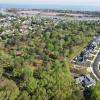Delaware Coastal Cleanup set with precautions Sept. 12
Volunteers are encouraged to mark their 2020 calendars now for the DNREC-sponsored 33rd annual Delaware Coastal Cleanup, tentatively planned for 9 a.m. to noon, Saturday, Sept. 12, with signup for large volunteer groups beginning in July, and overall volunteer registration opening in August. The cleanup spans the First State’s 97-mile eastern coastline, and includes river and ocean shorelines as well as wetland and watershed areas.
For the 2020 event, precautions will be taken to ensure the health and safety of cleanup participants, who are spread out across 40 to 50 locations throughout the state, working outside and generally in groups no bigger than 10 to 15. Planning for this year’s event covers a wide range of contingencies, including possible cancellation, with decisions to be based on the most current coronavirus conditions.
Volunteer registration will be available online Saturday, Aug.1, at www.de.gov/coastalcleanup. Groups of 10 or more are strongly encouraged to preregister by emailing DNREC_Coastal_Cleanup@delaware.gov.
DNREC organizes Delaware’s Coastal Cleanup as part of the Ocean Conservancy’s annual International Coastal Cleanup. The Delaware Coastal Cleanup promotes clean beaches, waterways, wetlands and watersheds in support of Keep Delaware Litter Free, Gov.John Carney’s statewide anti-litter initiative.
Last year’s Delaware Coastal Cleanup drew 1,931 volunteers who collected 3.6 tons of trash and recyclables from 46 sites along more than 125 miles of Delaware’s waterways and coastline stretching from Wilmington to Fenwick Island.
Numbers increased for many common items. Food/beverage-related trash items nearly doubled to 42,462 pieces, including: 4,268 food wrappers, 4,043 plastic beverage bottles, 2,444 beverage cans, 1,453 glass bottles, and 2,851 paper, plastic and foam cups, plates and takeout containers. Common plastic items showed changes: 2,172 plastic bags, increased from 1,946; 2,397 straws and stirrers, decreased from 2,738; 1,434 plastic lids, up from 1,116; and 6,319 plastic bottle caps, down from 7,026.
Other notable items found include 66 tires, 119 shotgun shells, 13,168 cigarette butts and cigar tips, 517 balloons, and dozens of sports balls, including golf, football, tennis, lacrosse, and basketballs, as well as Frisbees.
Some of the more unusual items found were: a wedding dress, life jacket, sippy cup, bike pedal, bushel basket, brake rotor, car bumper, garden rake, half an anchor, mattress springs, plastic pumpkin, plush unicorn, two boxes of fireworks, baby shoes, ladder, vintage baby doll, lip gloss, artificial Christmas tree, an Adopt-A-Highway sign, cellphone, pop-up tent, broken canopies, tent spike, toilet seats, sledgehammer, nose clip, lawn chair, boat propeller, two baby strollers, four television sets at one site, a floating dock, and 348 all-the-same-brand beer cans in one location.
As part of the Ocean Conservancy’s International Coastal Cleanup, the types and quantities of trash collected in Delaware are recorded on data cards and forwarded by DNREC to the Center for Marine Conservation, which compiles the information to help identify debris sources and focus efforts on elimination or reduction.
For more information, go to www.oceanconservancy.org.




















































